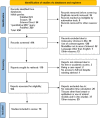Applications of T1 and T2 relaxation time calculation in tissue differentiation and cancer diagnostics-a systematic literature review
- PMID: 36531030
- PMCID: PMC9749890
- DOI: 10.3389/fonc.2022.1010643
Applications of T1 and T2 relaxation time calculation in tissue differentiation and cancer diagnostics-a systematic literature review
Abstract
Introduction: The purpose of this review was to summarize current applications of non-contrast-enhanced quantitative magnetic resonance imaging (qMRI) in tissue differentiation, considering healthy tissues as well as comparisons of malignant and benign samples. The analysis concentrates mainly on the epithelium and epithelial breast tissue, especially breast cancer.
Methods: A systematic review has been performed based on current recommendations by publishers and foundations. An exhaustive overview of currently used techniques and their potential in medical sciences was obtained by creating a search strategy and explicit inclusion and exclusion criteria.
Results and discussion: PubMed and Elsevier (Scopus & Science Direct) search was narrowed down to studies reporting T1 or T2 values of human tissues, resulting in 404 initial candidates, out of which roughly 20% were found relevant and fitting the review criteria. The nervous system, especially the brain, and connective tissue such as cartilage were the most frequently analyzed, while the breast remained one of the most uncommon subjects of studies. There was little agreement between published T1 or T2 values, and methodologies and experimental setups differed strongly. Few contemporary (after 2000) resources have been identified that were dedicated to studying the relaxation times of tissues and their diagnostic applications. Most publications concentrate on recommended diagnostic standards, for example, breast acquisition of T1- or T2-weighted images using gadolinium-based contrast agents. Not enough data is available yet to decide how repeatable or reliable analysis of relaxation times is in diagnostics, so it remains mainly a research topic. So far, qMRI might be recommended as a diagnostic help providing general insight into the nature of lesions (benign vs. malignant). However, additional means are generally necessary to differentiate between specific lesion types.
Keywords: MRI; T1 relaxation time; T2 relaxation time; cancer; diagnostics.
Copyright © 2022 Micek, Aebisher, Surówka, Bartusik-Aebisher and Madera.
Conflict of interest statement
Authors MaM, JS and MiM were employed by SoftSystem Sp. z o.o. The remaining authors declare that the research was conducted in the absence of any commercial or financial relationships that could be construed as a potential conflict of interest.
Figures
References
-
- The American Society of Breast Surgeons . Official statements (2017). Available at: https://www.breastsurgeons.org/docs/statements/Consensus-Guideline-on-Di... (Accessed 20 March 2020).
-
- European Commission . European Guidelines on breast cancer screening and diagnosis . Available at: https://healthcare-quality.jrc.ec.europa.eu/ecibc/european-breast-cancer... (Accessed 19 March 2020).
-
- European Commission . Tailored screening in women with high breast density: Magnetic resonance imaging . Available at: https://healthcare-quality.jrc.ec.europa.eu/european-breast-cancer-guide... (Accessed 19 March 2020).
-
- Mann RM, Athanasiou A, Baltzer PA, Camps-Herrero J, Clauser P, Fallenberg EM, et al. . Breast cancer screening in women with extremely dense breasts recommendations of the European society of breast imaging (EUSOBI). Eur Radiol (2022) 32(6):4036–45. doi: 10.1007/s00330-022-08617-6 - DOI - PMC - PubMed
Publication types
LinkOut - more resources
Full Text Sources




